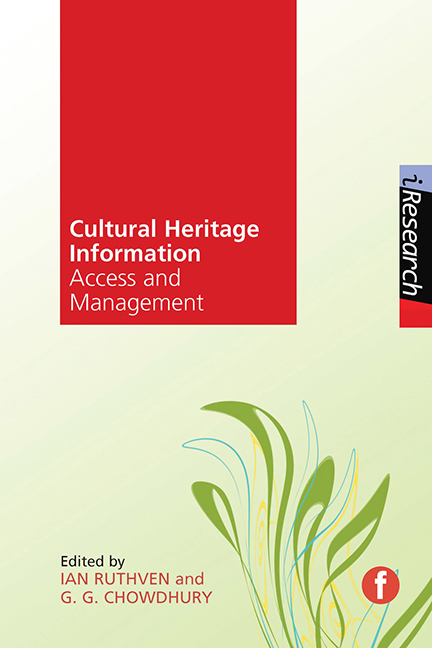Book contents
- Frontmatter
- Contents
- List of figures and tables
- Contributors
- Preface
- 1 Managing digital cultural heritage information
- 2 Digital humanities and digital cultural heritage (alt-history and future directions)
- 3 Management of cultural heritage information: policies and practices
- 4 Cultural heritage information: artefacts and digitization technologies
- 5 Metadata in cultural contexts – from manga to digital archives in a linked open data environment
- 6 Managing cultural heritage: information systems architecture
- 7 Cultural heritage information: users and usability
- 8 A framework for classifying and comparing interactions in culturalheritage information systems
- 9 Semantic access and exploration in cultural heritage digital libraries
- 10 Supporting exploration and use of digital cultural heritage materials: the PATHS perspective
- 11 Cultural heritage information services: sustainability issues
- Index
2 - Digital humanities and digital cultural heritage (alt-history and future directions)
Published online by Cambridge University Press: 10 September 2022
- Frontmatter
- Contents
- List of figures and tables
- Contributors
- Preface
- 1 Managing digital cultural heritage information
- 2 Digital humanities and digital cultural heritage (alt-history and future directions)
- 3 Management of cultural heritage information: policies and practices
- 4 Cultural heritage information: artefacts and digitization technologies
- 5 Metadata in cultural contexts – from manga to digital archives in a linked open data environment
- 6 Managing cultural heritage: information systems architecture
- 7 Cultural heritage information: users and usability
- 8 A framework for classifying and comparing interactions in culturalheritage information systems
- 9 Semantic access and exploration in cultural heritage digital libraries
- 10 Supporting exploration and use of digital cultural heritage materials: the PATHS perspective
- 11 Cultural heritage information services: sustainability issues
- Index
Summary
Introduction
Most commentators locate the origin of digital humanities (DH) in humanities computing of the mid-20th century. Dalbello (2011), for example, begins her account in 1946 with Roberto Busa's Index Thomisticus, a massive attempt to encode nearly 11 million words of Thomas Aquinas on IBM punch cards. This event (and the narrative that follows) is found throughout the literature, leading some to believe that early DH work ‘concentrated, perhaps somewhat narrowly, on text analysis (such as classification systems, mark-up, text encoding, and scholarly editing)’ (Presner, 2010, 6). Others seem convinced that DH is still only text analysis – and misguided in its approach (Fish, 2012b).
Acceptance rates for the Digital Humanities conference indeed reflect a strong interest in text and language (Weingart, 2013), but most of the projects are rooted in fields other than computational linguistics. The interdisciplinary nature of DH has opened doors to geographers (through GIS), social scientists (through statistics and network analysis), information scientists (through visualization and citation analysis), demographers (through decomposition and event analysis), engineers and architects (through modelling), media studies scholars (through gaming and new media formats), computer scientists (through a great variety of code that supports this work), and more. Alternative histories of DH, grounded in these and other disciplines, remain to be written, and this chapter addresses yet another field: cultural heritage (through source materials) and its relation to DH.
The first section of this chapter is critical, discussing historical accounts in the literature and arguing for alt[ernate-]histories of DH. Scheinfeldt (2014) has recently issued a similar call for recognizing disciplinary diversity in the history of DH. The second part of this chapter is constructive, sketching a history of DH based on cultural heritage institutions, including libraries, archives, and museums (LAMs). The third section is prospective, examining possibilities for overlap between DH and cultural heritage institutions. In some cases, cultural heritage institutions and the humanities face parallel challenges (e.g., threats to funding, an increasing need to demonstrate public relevance), which could be met jointly by both fields. In these instances, cultural heritage institutions and DHers will be aligned in their structures and values, making for flexible, even seamless partnerships. In other cases, however, the movement of DH may invite a fresh examination of traditional missions and practices within cultural heritage and suggest new directions for policy and management.
- Type
- Chapter
- Information
- Cultural Heritage InformationAccess and Management, pp. 13 - 36Publisher: FacetPrint publication year: 2015
- 3
- Cited by



